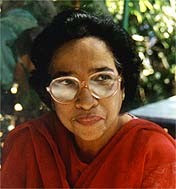In the early 20th Century,
Victorian England was shocked out of its prudery by a woman called Marie
Stopes, who made it her vocation to inform the women of her day, that the
enjoyment of sex was not just a male prerogative, but could be enjoyed by women
too, without fear of pregnancy. What surprised everyone was that she was
neither a doctor nor a sex therapist but a spinster, with Botany and Geology as
subjects of specialization. Perhaps her friendship with Margaret Sanders an
advocate for Birth Control induced her to make a lifelong commitment to the
Birth Control Movement.
Marie’s
first book “Married Love” was considered scandalous, and was turned down by a
number of publishers. They found her theory, that marriage can be happy only if
the couple has a mutually satisfying sex life, to be offensive. But a rich and
influential man called Humphrey Verdon Roe got it published on 20th
March 1918, even though the contents shocked the world. This man later became
her second husband, and with his help she was able to establish the first Birth
Control Clinic in 1921, in the Holloway district of London.
Marie’s
second book “Wise Parenthood” was written after her marriage but before she
became a parent. It was addressed to middle class women. Later, she brought out
a condensed form of its contents, as a news letter, which was specially
directed to poor women. It was titled “A letter to working class mothers – How
to have healthy children and avoid weakening pregnancies.” But the poor ignored
her letter and called her ‘a well intentioned meddler.’
Both Protestant and Catholic churches denounced her
‘indecent literature’ and were opposed to the sale of condoms. The Birth
Control Clinic was open only to married women. It was manned by midwives and
visiting doctors. Women were taught to use the cervical cap. Marie was against
abortions.
In
1922, the cervical cap which she promoted was criticized vehemently by Halliday
Gibson Sutherland. It led to bitter fights between them, which ended in a legal
battle. Unluckily for Marie, Sutherland won the case.
Over
the following years, Marie opened clinics in different parts of the British
Isles. With fellow family planning pioneers, she established the National Birth
Control Council in 1930. It was committed to improving the reproductive health
of women and breaking down existing taboos.
Marie
Stopes was born in Edinburgh on October 5th 1880. Both her parents
were scholars who ensured that their intelligent daughter had a good education.
She entered the University of London on a scholarship to study Botany and
Geology. She secured a First Class in her B.Sc degree in 1902, followed by D.Sc
and was the youngest person to do so. After extensive research in both
subjects, Marie transferred to the University of Munich in 1904, for her PhD in
Paleobotany. She then became a lecturer at the University of Manchester, and
was the first female academic to be appointed on the Science staff of the
University. But after a few years, she resigned her lectureship to concentrate
on her Birth Control Clinic.
The
quirks in her character however, were too blatant to ignore. Her first husband
was a Canadian scientist called Reginald Ruggles Gates. She divorced him two
years later in 1916, because her sex life was unfulfilling and was never
consummated.
In 1918, she married the wealthy Humphrey Verdon
Roe, and forced her husband to sign a pre-nuptial document to free her of
sexual fidelity if he was unable to satisfy her.
Marie’s
first child was stillborn in 1919. At the age of 43, her second son Harry
Stopes Roe was born. She was a dominating mother who controlled every aspect of
his life. When he grew up, he married against her will. Her main objection was
that the girl wore spectacles, and there was a possibility of his children
being damaged through imperfections. Mother and son were estranged till her
death.
Though
Marie disliked Hitler, she sent him a compilation of “Love Songs for Young Lovers,”
Her son put this down to her megalomania and not because of any affection for
him. But one presumes that her support for Eugenics was inspired by Hitler. She
advocated sterilization of physically disabled and mentally retarded women
calling them “inferior, depraved and feeble minded.” She believed that the
human race would decline if such people were allowed to procreate. Like Hitler
she was anti-Semitic, anti-Catholic and anti-Russian.
But
Hitler closed down her Birth Control clinics in Germany. So in 1940, she wrote
a note to Churchill suggesting a slogan for the war against Hitler, “Fight the
Battle of Britain in German Air.”
Marie
was a harridan. Verdon Roe her husband had to put up with many humiliating
restrictions. After World War II, she took to writing poetry and literature.
She even wrote children’s stories under the name of Erica Fay.
Marie
died of Breast Cancer on October 2nd, 1958. She bequeathed her
mansion and entire estate to the Royal Society of Literature. To Harry her only
son, she left 13 volumes of the Greater Oxford Dictionary.
But
in spite of her eccentricities, she has been immortalized through the Marie Stopes
International Organization which was started in 1976, and now covers 41 countries
through a network of 600 centres.
Not
many know that this champion of women’s rights had a small stone cottage on the
Isle of Portland, where she used to hide during her stressful days of battle with
Sutherland. In 1930, she converted it into the Portland Museum and presented it
to the people of Portland. The museum in Church Ope Cove at Wakeham is a lovely
place to visit. The exhibits there depict the history of the Isle of Portland.






